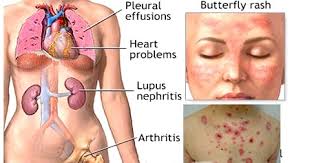What do you know about systemic lupus erythematosus?
Systemic lupus erythematosus is an immune system disorder. Immune cells attack the body's healthy tissues, leading to inflammation and tissue damage. Symptoms appear on the skin, but often systemic lupus erythematosus also causes internal problems such as joint pain. In severe cases, it can damage the heart, kidneys, and other vital organs. Although there is no cure, there are treatments that can minimize the damage.
Symptoms of systemic lupus erythematosus:
Joint pain: Joint and muscle pain is often the first sign of systemic lupus erythematosus. This pain is symmetrical (tends to appear on both sides of the body at the same time), especially in the joints of the wrists, hands, fingers, and knees. The joints become inflamed. But unlike rheumatoid arthritis, systemic lupus erythematosus does not usually cause permanent joint damage.
Redness: The most common symptom of systemic lupus erythematosus is a butterfly-shaped rash that appears on the cheeks and down the bridge of the nose. Lupus also causes red, scaly spots on other parts of the body: the skin, neck, hands.

Fever: One of the early signs of lupus is a low-grade fever with no apparent cause. Since fevers are usually around 100 to 101 degrees Fahrenheit (37 to 38.5 degrees Celsius), you may not need to see a doctor. These fevers will often come and go, then come again, over and over again. A low-grade fever can be a sign of inflammation, infection, or an impending flare-up.
Hair loss : is a result of inflammation of the skin and scalp. Some people with lupus lose patches of hair, but more often, hair loss occurs gradually, bit by bit. Some people also have thinner eyebrows, eyelashes, and hair elsewhere on their body. Lupus can cause your hair to become dry and brittle. Treating lupus can help your hair grow back. However, if you have scarring on your scalp, baldness in that area may be permanent.

Cardiac manifestations : Patients with systemic lupus erythematosus may develop inflammation of various parts of the heart, such as pericarditis (also called pericarditis), myocarditis, and endocarditis (also called endocarditis). The endocarditis in this disease is typically noninfectious (Libman-Sacks endocarditis) and may involve the mitral or tricuspid valve. Atherosclerosis is also more common and progresses more rapidly in patients with systemic lupus erythematosus.
Lung symptoms: Inflammation of the lungs and pleura can cause pleurisy, pleural effusion, lupus pneumonia, chronic diffuse interstitial lung disease, pulmonary hypertension, pulmonary embolism, pulmonary hemorrhage, and shrinking lung syndrome.
Kidney symptoms: Hematuria (blood in the urine) or proteinuria (protein in the urine) is the only sign of kidney damage. Acute or chronic kidney damage can develop into lupus nephritis, leading to acute or end-stage renal failure. If SLE is diagnosed and treated early, end-stage renal failure occurs in less than 5% of cases.
The histological hallmark of systemic lupus erythematosus is membranous glomerulonephritis with an unusual “wire ring” appearance. This appearance is due to the deposition of immune complexes along the glomerular basement membrane, producing a typical granular appearance on immunofluorescence.

Neurological manifestations: Neuropsychiatric disorders occur when systemic lupus erythematosus affects the central or peripheral nervous system. This syndrome is challenging to doctors because it is associated with many other symptoms.
The most common neuropsychiatric manifestations that patients with systemic lupus erythematosus suffer from are headaches, dementia, mood disorders, and cerebrovascular diseases.
Digestive symptoms: Digestive problems are not common in systemic lupus erythematosus, but some people may experience abdominal pain, nausea, vomiting, difficulty swallowing, or inflammation of the liver or pancreas. This may be related to lupus itself or to the medications used to treat the disease. Some people may lose weight during flare-ups.
Depression and anxiety is a risk for people with systemic lupus erythematosus. This may be a result of the condition's effects on the nervous system combined with the stress of dealing with a chronic illness. Share this with your doctor or health care provider.
Systemic lupus erythematosus is a dangerous disease that affects important organs of the body, so when you have the above symptoms, you should go to medical facilities for timely examination and treatment.








